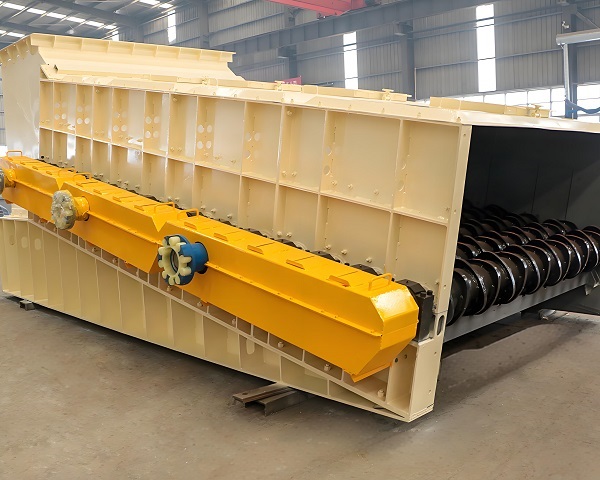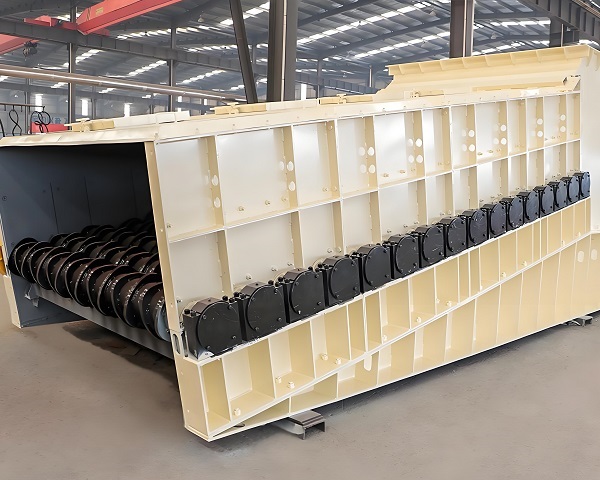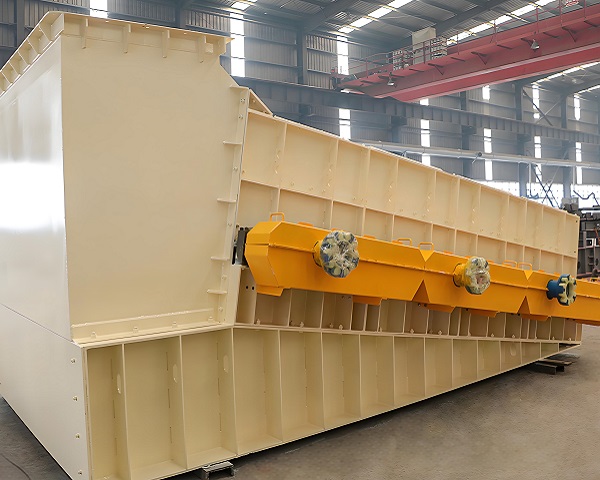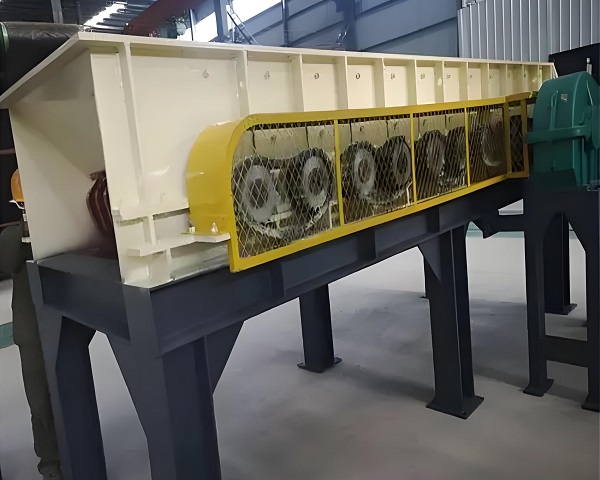A Trommel Screen is a rotary drum screening machine widely used in waste processing, mining, and construction industries. It efficiently separates materials by ......
What is the Disc Screen for Sale
Disc Screen is an efficient equipment that relies on rotating discs to achieve material screening and grading. It plays an important role in industrial production, resource recycling and other fields.
The core structure of the disc screen consists of a series of rotating discs arranged in parallel. These discs are connected by a central axis, and the surface is usually provided with toothed, rod-shaped or corrugated structures. When working, the motor drives the central axis to drive the disc to rotate, and the material enters from one end of the screen body. Under the combined action of centrifugal force, friction and gravity generated by the rotation of the disc, the material smaller than the gap of the disc falls through the gap and becomes the underscreen; the material larger than the gap moves along the surface of the disc to the outlet to achieve screening and grading. This unique screening method enables the disc screen to have higher screening efficiency and processing capacity.
Compared with traditional screening equipment, the disc screen has significant advantages. It has a compact structure and small footprint, which is especially suitable for working environments with limited space. In addition, the disc screen has strong adaptability to materials. Whether it is granular sand and gravel, coal, or irregularly shaped waste, it can effectively screen; in the face of wet and sticky materials, the dynamic action of the rotating disc can also reduce material adhesion and blockage. The maintenance of the equipment is relatively convenient, and the modular design makes it easy to disassemble and replace wearing parts such as discs and bearings, reducing downtime and maintenance costs.
The application scenarios of the disc screen are very wide. In the mining field, it can be used for the primary screening of ore, separating ores of different particle sizes and improving the efficiency of subsequent mineral processing; in the treatment of construction waste, it can quickly screen concrete blocks, brick and tile fragments, etc., to help the production of recycled aggregates; in the agricultural industry, it can grade and screen grains, seeds, etc. to ensure product quality. At the same time, in the process of sorting urban domestic waste, the disc screen can effectively separate waste of different materials such as plastics, metals, and fabrics, and promote resource recycling.
With the development of science and technology, the disc screen is also constantly upgrading and innovating. The introduction of intelligent control system enables it to automatically adjust parameters such as rotation speed and disc spacing according to material characteristics; the application of new materials enhances the wear resistance and corrosion resistance of the equipment. In the future, the disc screen will provide better solutions for material screening in various industries with a more efficient, intelligent and environmentally friendly attitude.
Operating principle of Disc Screen for Sale
Disc Screen is a device that achieves material screening through a unique disc rotating structure. It is widely used in garbage disposal, ore sorting, building material processing and other fields. Its working principle is based on the ingenious combination of mechanical movement and physical screening.
The core structure of the disc screen consists of a series of discs mounted on a horizontal axis. These discs are usually arranged in a staggered or evenly spaced pattern to form a screen surface. The surface of the disc can be smooth or designed with special shapes such as protrusions and teeth according to screening requirements. When the equipment is running, the motor drives the horizontal axis to rotate through the transmission device, which in turn drives the disc to rotate synchronously. When the material is conveyed to the feed end of the disc screen, it first contacts the rotating disc, and driven by the disc, the material begins to move along the screen surface.
During the screening process, material particles smaller than the disc spacing or the size of the sieve holes, under the combined action of gravity, centrifugal force and the mechanical force generated by the rotation of the disc, pass through the gaps between the discs or the sieve holes on the sieve disc, and fall to the collection device below to complete the screening; while materials larger than the sieve hole size continue to move on the disc surface and are pushed forward by the disc until they are discharged from the end of the screen surface and become the screen material.
The rotation speed and angle of the disc are key parameters affecting the screening effect. A higher rotation speed can speed up the movement of materials on the screen surface and improve the processing efficiency, but too fast a speed may cause the material to be discharged before it is fully screened; and the appropriate disc tilt angle can control the residence time and movement trajectory of the material on the screen surface, ensuring that the material has enough time to contact the sieve holes and improve the screening accuracy. In addition, the disc screen can also flexibly adapt to the screening needs of materials of different particle sizes and properties by adjusting the disc spacing and replacing sieve discs with different apertures according to the characteristics of the material.
In practical applications, the disc screen is particularly suitable for processing materials with irregular shapes, easy entanglement or high viscosity. Compared with traditional screening equipment, its unique disc structure can effectively avoid material blockage and reduce screen wear. At the same time, the mechanical action of the disc can also initially crush and loosen the material, further improving the screening effect. This efficient, flexible and durable screening principle makes the disc screen an important equipment for material pretreatment and fine screening in many industrial fields.
Advantages and features of Disc Screen for Sale
The core component of the Disc Screen is a series of rotating discs mounted on a horizontal axis. The disc surface has specially shaped protrusions or sieve holes. The rotating motion of the discs can screen and convey materials, and achieve efficient material classification.
In terms of screening efficiency, the Disc Screen performs well. The continuous rotation of the discs can continuously push the material forward while screening. Compared with traditional fixed screen equipment, the disc screen does not require the material to slowly pass through the screen by its own gravity, which greatly speeds up the material processing speed. When processing large-scale materials, its efficiency is more prominent. For example, in the screening process of construction aggregates, sand and gravel of different particle sizes can be quickly separated, effectively improving production efficiency.
High adaptability is another highlight of the Disc Screen. The disc screen can easily adapt to various materials of different properties and particle size ranges by adjusting the disc spacing, rotation speed, and replacing discs with different mesh specifications. Whether it is processing ore with uniform particle size or construction waste with large particle size differences and irregular shapes, it can respond flexibly. Moreover, its unique design makes it less prone to clogging when handling sticky or wet materials, ensuring stable and continuous screening.
Disc Screen has obvious advantages in terms of maintenance. The structure of the equipment is relatively simple, and key components such as discs and bearings are easy to disassemble and replace. Daily maintenance mainly focuses on lubrication and wear inspection of rotating parts, without the need for complex maintenance processes and professional tools, effectively reducing maintenance costs and downtime, and improving the availability and service life of the equipment.
In addition, Disc Screen has a wide range of application scenarios. It is not only suitable for material screening in the mining and construction industries, but also plays an important role in agriculture, environmental protection and other fields. In agriculture, it can be used for screening and grading of crop seeds; in the environmental protection industry, it can perform preliminary screening of garbage to help resource recycling and garbage disposal. At the same time, its operation process has low noise, is friendly to the working environment, and meets the requirements of modern industrial green production.
Disc Screen occupies an important position in the field of material screening with its efficient screening capacity, wide adaptability, convenient maintenance and environmental protection characteristics, providing reliable and efficient solutions for material handling in various industries.
Technical Parameter Table of Disc Screen for Sale
| Model | Disc Diameter (mm) | Disc Spacing (mm) | No. of Decks | Screen Cut Size (mm) | Max Capacity (TPH) | Motor Power (kW) | Disc Material |
|---|---|---|---|---|---|---|---|
| DS-500 | 300 | 120 | 1 | 10 – 30 | 15 | 2.2 | Polyurethane |
| DS-800 | 400 | 150 | 2 | 20 – 50 | 35 | 3.0 | Wear-Resistant Rubber |
| DS-1200 | 500 | 180 | 2 | 30 – 70 | 60 | 5.5 | Alloy Steel |
| DS-1800 | 600 | 200 | 3 | 40 – 100 | 100 | 7.5 | Rubber + Steel Core |
| DS-2500 | 800 | 250 | 3 | 80 – 150 | 150 | 11.0 | High-Strength Polyurethane |
If you have any special requirements, we will customize according to your special needs.
Product Picture Display of Disc Screen for Sale
FAQ about Disc Screen for Sale
>How to determine the mesh size of Disc Screen?
The mesh size needs to be determined based on the material characteristics, screening purpose and processing efficiency. Choose the appropriate aperture according to the maximum particle size of the material and the target product specifications, such as large aperture (50-100mm) for coarse screening and small aperture (1-10mm) for fine screening. At the same time, factors such as material shape and humidity should be considered to avoid mesh blockage or insufficient screening.
>What is the impact of the speed of the Disc Screen disc on the screening effect?
The disc speed affects the movement speed and jumping height of the material on the screen surface. Fast speed means fast material movement and high processing capacity, but the screening accuracy may decrease; slow speed means long material residence time and more complete screening, but low processing efficiency. It is necessary to adjust to the optimal speed according to the material characteristics to balance efficiency and accuracy.
>Can Disc Screen handle wet materials?
Yes. The rotating motion of the disc causes the material to tumble and jump continuously, reducing the contact time with the screen surface and effectively preventing the material from sticking and clogging the mesh. Even wet, sticky sludge, wet sand and other materials can be efficiently screened by adjusting the equipment parameters.
>What is the processing capacity of Disc Screen?
The processing capacity is affected by the diameter, number, speed, mesh size and material characteristics of the disc. Large Disc Screen can process hundreds of tons of materials per hour. For example, in a garbage treatment plant, a single device can screen 100-200 tons of mixed garbage per hour; small equipment is suitable for laboratories or small-scale production, and the processing capacity is relatively low.
>How to install and debug Disc Screen?
During installation, ensure that the equipment is placed horizontally, fix the drive device and screen plate assembly, connect the transmission components and check the concentricity. During debugging, run it without load first, check whether the vibration, noise and speed of the equipment are normal; then gradually load the material, observe the screening effect, and adjust the speed, inclination and other parameters to the best working conditions.
>What is the working principle of Disc Screen?
The drive shaft of Disc Screen drives a series of equally spaced discs to rotate. When the material moves on the surface of the disc, particles smaller than the disc gap or mesh fall down to complete the screening. The rotating motion of the disc causes the material to jump and tumble, which not only speeds up the screening speed, but also reduces the clogging of the screen holes, achieving efficient grading.
>What are the main applications of Disc Screen?
Disc Screen is widely used in the field of solid waste treatment to screen and classify mixed garbage; it is used for the initial screening and selection of ore in the mining industry; it can screen sand and gravel aggregates in the construction industry; it is used for fruit and vegetable sorting and grain impurity removal in the agricultural field; it can also be used for screening operations such as biomass and chemical raw materials.
>What are the advantages of Disc Screen compared to other screening equipment?
Compared with traditional screening equipment, Disc Screen has a stronger anti-blocking ability, and the disc structure is not easily stuck by long strips and winding materials. It has high screening efficiency, large processing capacity, and can adapt to wet and sticky materials. The equipment operates stably, is simple to maintain, has a long service life, and can reduce the overall operating cost.
>What does the daily maintenance of Disc Screen include?
Daily maintenance requires checking the wear of the disc and replacing the seriously worn parts in time; lubricating the transmission parts regularly to prevent dry grinding of bearings, journals and other parts; cleaning the residual materials on the surface of the sieve disc and the sieve holes to avoid accumulation that affects the screening effect; checking the tightness of the transmission belt or chain to ensure stable operation of the equipment.
>What faults may occur during the operation of the Disc Screen and how to solve them?
Common faults include abnormal rotation of the disc, which may be caused by loose belts and damaged bearings, and the belt tension needs to be adjusted or the bearings need to be replaced; the blockage of the sieve holes is mostly caused by the high viscosity of the material, which can be solved by adjusting the speed and flushing the screen surface; excessive vibration of the equipment may be caused by uneven installation or loose parts, and the level needs to be recalibrated and the bolts tightened.
>Can the Disc Screen be customized to meet special needs?
Yes. The manufacturer can customize the disc material (such as stainless steel, wear-resistant alloy), the shape and size of the sieve holes, the length and width of the equipment, and the degree of automation according to customer needs. For example, for corrosive materials, corrosion-resistant materials are used; for high production requirements, the number of discs and the length of the equipment are increased.
>Is the energy consumption of the Disc Screen high?
The energy consumption of Disc Screen is relatively reasonable. Its power consumption mainly comes from the rotation of the driving disc. By optimizing the disc structure and transmission system, the running resistance can be reduced and the energy utilization efficiency can be improved. Compared with some vibrating screens, Disc Screen has more controllable energy consumption due to its stable operation characteristics.
>How does Disc Screen improve recycling efficiency in solid waste treatment?
In solid waste treatment, Disc Screen separates garbage of different sizes through multi-stage screening, so that recyclable materials such as metals and plastics can be collected in a centralized manner. Its anti-winding and anti-blocking characteristics prevent long strips of garbage from getting stuck in the equipment, ensuring continuous operation and significantly improving garbage sorting efficiency and resource recovery rate.
>How long is the service life of Disc Screen?
Under normal maintenance, the service life of Disc Screen can reach 5-10 years. Its core components such as discs and drive shafts are made of wear-resistant materials, but the actual service life is affected by factors such as material hardness, frequency of use, and maintenance. Regular maintenance and replacement of wearing parts can extend the overall service life of the equipment.
>What is the main difference between Disc Screen and vibrating screen?
Compared with vibrating screen, Disc Screen relies on disc rotation for screening, with smooth movement, small impact on the foundation and low noise; while vibrating screen achieves screening through vibration, with large vibration amplitude, which is easy to generate noise and equipment wear. Disc Screen has strong anti-clogging ability and is suitable for processing complex materials, while vibrating screen is more suitable for screening granular and fluid materials.

































